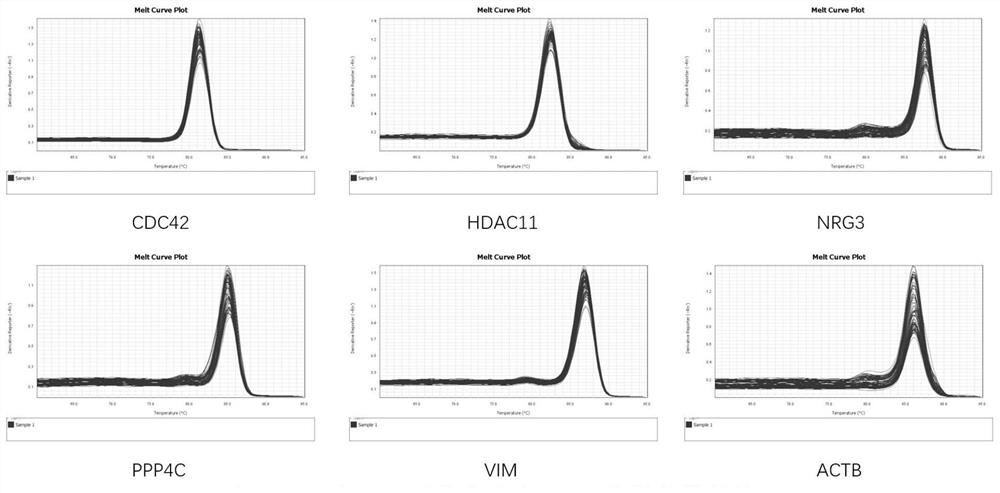Application of immune-related genes in kit and system for predicting prognosis of diffuse glioma
A glioma and kit technology, applied in the field of biomedicine, can solve the problems of no large-scale research on diffuse glioma, no immune-related genes, and no large-scale verification.
- Summary
- Abstract
- Description
- Claims
- Application Information
AI Technical Summary
Problems solved by technology
Method used
Image
Examples
Embodiment 1
[0021] Construction of immune prognostic model of diffuse glioma ( figure 1 ):
[0022] Download the GSE4290 dataset from the GEO database, which contains 153 cancer tissues and 27 paracancerous tissues.
[0023] The limma R package was used to analyze the differential expression of the cancer group and the adjacent cancer group in the GSE4290 dataset. The screening criteria for differentially expressed genes were |log2foldchange|>0.5 and p.adjust<0.05. After differential expression analysis, a total of 3383 differentially expressed genes were obtained. genes, including 1459 up-regulated genes and 1924 down-regulated genes.
[0024] The immune-related genes were obtained from the ImmPort database, with a total of 1811 genes. These genes were intersected with differentially expressed genes to obtain 236 differentially expressed immune-related genes (DE-IRGs).
[0025] Using these 236 DE-IRGs to perform weighted co-expression network analysis in the CGGA dataset to obtain the ...
Embodiment 2
[0029] Use this model to predict the prognosis of diffuse glioma;
[0030] Tested on a training cohort (CGGA) and a validation cohort (TCGA) with a total of 902 case samples. like Figure 1 shown, where the test effect in CGGA (1-, 3-, and 5-year AUC values were 0.795, 0.855, and 0.896, respectively), and the test effect on glioma patients in the TCGA validation set (1-, 3-, and 5-year AUC values, respectively) The 5-year AUC values were 0.815, 0.855 and 0.813)
[0031] As shown in Table 1 and Table 2, the present invention also carried out univariate cox regression analysis and multivariate cox regression analysis, which proves that the immune risk score model (IRGS) calculated by the model of the present invention can indeed independently predict the prognosis risk of glioma patients .
[0032]Finally, it should be noted that the above embodiments are only used to illustrate the technical solutions of the present invention and not to limit the protection scope of the ...
Embodiment 3
[0058] Expression levels of genes used to validate immune prognostic models in clinical samples
[0059] Based on the GEO database and TCGA database to construct and preliminarily validate the immune prognosis model of diffuse glioma, we collected 12 diffuse glioma tissue samples from the hospital (728487G, 691253G, 689599G, 695948G, 754905G, 719303G, 779526G, 756384G, 786591G, 700690G, 694592G, 701763G) and 6 normal tissue samples (709872N, 531955N, 786009N, 605854N, 705306N, 474898N). Total RNA was extracted, and the expression levels of 5 IPS genes used in the immune prognosis model were detected by qPCR: CDC42, PPP4C, NRG3, VIM and HDAC1. ACTB was used as an internal reference positive control. The assessed significance of our model was validated at the qPCR level.
[0060] Table 3. qPCR primer table
[0061]
[0062]
[0063] "-F" indicates forward primer and "-R" indicates reverse primer.
[0064] Main instruments and reagents used for qPCR validation
[0065] ...
PUM
 Login to View More
Login to View More Abstract
Description
Claims
Application Information
 Login to View More
Login to View More - Generate Ideas
- Intellectual Property
- Life Sciences
- Materials
- Tech Scout
- Unparalleled Data Quality
- Higher Quality Content
- 60% Fewer Hallucinations
Browse by: Latest US Patents, China's latest patents, Technical Efficacy Thesaurus, Application Domain, Technology Topic, Popular Technical Reports.
© 2025 PatSnap. All rights reserved.Legal|Privacy policy|Modern Slavery Act Transparency Statement|Sitemap|About US| Contact US: help@patsnap.com



